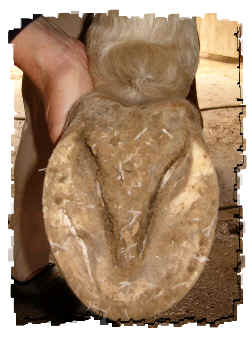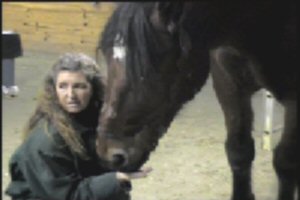Bruising, etc.
Q: I have a 7 year old gelding that is a pro caliber barrel horse. He has been competed on since he was 4.Early this summer I took the horse to Dr Hague in Oklahoma to be evaluated due to being uncomfortable on his feet. We did an MRI and this is the diagnosis.1. Bone Bruise right coffin medial wing and toe2. Bone bruise left coffin toe3. Inflamation of digital cushion at heels bilateral forelimbs4. desimitis of colateral ligaments of coffin joint bilaterally5. Synovitis bilateral coffin joints6. Navicular bursitis bilateral fore limbsHorse was stall bound 30 days and then confined another 30 days with egg bar aluminums and equathane then moved to performance shoes and lightly conditioned in a straight line for another 30. Horse continually rips off right front shoe as he has since I have owned him.5 different shoers have shod him. We have the front shoe balanced with the foot and the back shoe slid back to the white line at the toe at present. 1 week into shoeing..rips off right front shoe..again.All hock issues have been addressed with injections so an unsoundness issue in the rear should not be a factor.Integrity of foot is poor in the sense that the inside walls are very thin and close on the white line. No contraction of heels but pathalogically has thin soles.Brusing was accelerated due to front feet being out of balance. Frustrated shoers would shove shoe way forward and grind off the heels thus removing adaquete support of foot and thus heel bruising occured.Is barefoot the solution? I am concerned that barefoot would not protect the integrity of the sensitive tissues and bones in the foot.But I am sick on owning a horse for 2 years that has never had a set of shoes for 5 weeks.Help?
A: First off, let me say that I respect your decisions regardless of shod or barefoot. I am not a farrier; I treat horses professionally in the capacity of a natural hoofcare provider. I do advocate the use of boots; not shoes. My primary alliance is to the horse, not someone else's opinions or feelings, even the owners' EXCEPT when the owner is wanting what is best for his or her *horse*. You sound like you want what is best for the horse as well as your pocketbook and that is good. I would be a bit t'd off as well as you at this point in time. All the "symptoms" that you listed point to imbalancing of the hooves. Imbalancing AND the need for the hoof to be conditioned naturally. Let me explain. Two very important happenings have been recently discovered but right at this moment I am at a loss as to who "discovered" them. Either Dr. Bowker or Dr. Pollitt. 1. When a horse's hoof is imbalanced and improperly conditioned in a natural state there is little to NO "sling" underneath the navicular bone that helps suspension and connects the lateral cartilages from side to side. When a horse is allowed to naturally grow a natural hoof that "sling" grows, thickens and provides more suspension to the bony column and the foot in general. 2. The Digital Cushion of the horse in shoes or with other impediment issues is comprised mostly of fatty cartilage and the fat is constantly "squished" for a lack of a better term at this moment, as the horse weights the hoof during loading. The DC is flattened out and does not provide the shock absorbancy that a healthy, "natural" DC can. When the hooves are barefoot and conditioned and healthy, that DC is comprised of mostly fibrous cartilage ... good, strong fiberous material that provides adequate shock absorbancy and cushioning for the impact of weight loading to the foot. Big difference between the two -- fatty cartilage and fibrous cartilage. Logically, what happens when the shock system is not in full working order is pretty much what you've got on your hands ... bruising, inflammations, rubs, irritations and all the rest of the gamut. Instead of the "cushy" landing of the foot inside a fully working capsule, you've got jarring and tearing and bumping and bruising on bones and tissues not designed to withstand that kind of shock. More than that, if the hoof is not in balance and leveled properly, most likely the horse is not landing heel first and this puts even greater strain up through the bones of the lower limb as the shock goes straight there instead of being "filtered" or dissipated through the shock absorbing system of the frog and DC. This eventually causes "holding" patterns in the horse's musculoskelatal system as the horse begins to compensate and hold himself against discomforts which, eventually, progress into *pain* throughout the limbs and back as well as lameness in the hooves. Taking your horse barefoot with a physiologically CORRECT trim to allow the hooves to begin to function and evolve as nature intended may be the best thing for you to do in order to allow this horse to heal. He's young, he's, I assume, in good health thus resistant and will recover rapidly. Now, I might point out that to be in professional racing at 4 years old might have been enough to permanently damage your horse's back. The equine skeletal system, particularly the back, does not completely mature until around 6 years of age. This kind of heavy duty racing is the equivalent to professional football playing for a Junior High kid ... or even a High School kid who still has a few years til the body is fully matured. All the hoof care in the world may not be able to "cure" what is going on in his back BUT I fully believe that the correct, natural care will help to some degree. BTW ... my barefoot horse's time in a few races was 15.8 and 16.3 and he was 22 years old at the time with a middleaged Mom on his back hangin' on for dear life!!! He won the local championship for 2 years in a row (22 and 23 yrs. old) ... barefoot and against over 50 competitors. So, may not beat the national scores but sure was pretty impressive at the time for a barefoot, senior horse!!! Wish I had had the opportunity to ride him/race him when he was in his prime. -- Gwen
A: First off, let me say that I respect your decisions regardless of shod or barefoot. I am not a farrier; I treat horses professionally in the capacity of a natural hoofcare provider. I do advocate the use of boots; not shoes. My primary alliance is to the horse, not someone else's opinions or feelings, even the owners' EXCEPT when the owner is wanting what is best for his or her *horse*. You sound like you want what is best for the horse as well as your pocketbook and that is good. I would be a bit t'd off as well as you at this point in time. All the "symptoms" that you listed point to imbalancing of the hooves. Imbalancing AND the need for the hoof to be conditioned naturally. Let me explain. Two very important happenings have been recently discovered but right at this moment I am at a loss as to who "discovered" them. Either Dr. Bowker or Dr. Pollitt. 1. When a horse's hoof is imbalanced and improperly conditioned in a natural state there is little to NO "sling" underneath the navicular bone that helps suspension and connects the lateral cartilages from side to side. When a horse is allowed to naturally grow a natural hoof that "sling" grows, thickens and provides more suspension to the bony column and the foot in general. 2. The Digital Cushion of the horse in shoes or with other impediment issues is comprised mostly of fatty cartilage and the fat is constantly "squished" for a lack of a better term at this moment, as the horse weights the hoof during loading. The DC is flattened out and does not provide the shock absorbancy that a healthy, "natural" DC can. When the hooves are barefoot and conditioned and healthy, that DC is comprised of mostly fibrous cartilage ... good, strong fiberous material that provides adequate shock absorbancy and cushioning for the impact of weight loading to the foot. Big difference between the two -- fatty cartilage and fibrous cartilage. Logically, what happens when the shock system is not in full working order is pretty much what you've got on your hands ... bruising, inflammations, rubs, irritations and all the rest of the gamut. Instead of the "cushy" landing of the foot inside a fully working capsule, you've got jarring and tearing and bumping and bruising on bones and tissues not designed to withstand that kind of shock. More than that, if the hoof is not in balance and leveled properly, most likely the horse is not landing heel first and this puts even greater strain up through the bones of the lower limb as the shock goes straight there instead of being "filtered" or dissipated through the shock absorbing system of the frog and DC. This eventually causes "holding" patterns in the horse's musculoskelatal system as the horse begins to compensate and hold himself against discomforts which, eventually, progress into *pain* throughout the limbs and back as well as lameness in the hooves. Taking your horse barefoot with a physiologically CORRECT trim to allow the hooves to begin to function and evolve as nature intended may be the best thing for you to do in order to allow this horse to heal. He's young, he's, I assume, in good health thus resistant and will recover rapidly. Now, I might point out that to be in professional racing at 4 years old might have been enough to permanently damage your horse's back. The equine skeletal system, particularly the back, does not completely mature until around 6 years of age. This kind of heavy duty racing is the equivalent to professional football playing for a Junior High kid ... or even a High School kid who still has a few years til the body is fully matured. All the hoof care in the world may not be able to "cure" what is going on in his back BUT I fully believe that the correct, natural care will help to some degree. BTW ... my barefoot horse's time in a few races was 15.8 and 16.3 and he was 22 years old at the time with a middleaged Mom on his back hangin' on for dear life!!! He won the local championship for 2 years in a row (22 and 23 yrs. old) ... barefoot and against over 50 competitors. So, may not beat the national scores but sure was pretty impressive at the time for a barefoot, senior horse!!! Wish I had had the opportunity to ride him/race him when he was in his prime. -- Gwen

